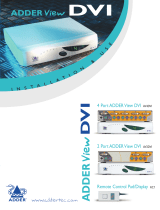
5
AdderView CATx features - front and rear
The AdderView CATx units pack a great deal of functionality into a compact
space. All models occupy a single 1U rack space and provide most of their
connectors at the rear face. The smart front face features the IP network port
and the operation indicators.
Power control port
Optionally use this port to control one or more
power switches. These allow the remote user
to take full control of the computer system(s).
Local user port
Connect a keyboard and mouse (either PS/2-style
or USB), plus a video monitor and optional speakers
to these connectors. These allow you to perform
the initial configuration of the AdderView CATx.
Additionally, you can use these to locally control the
connected computer(s).
Computer ports
Each computer connects to one of these ports
via standard category 5, 5e or 6 cabling. At the
other end of the cabling a CAM (Computer Access
Module) is used to provide the necessary keyboard,
video, mouse and optional speaker connections.
Modem port (IP models only)
Optionally use this port to attach either a
standard modem or an ISDN adapter. This
feature provides an alternative, direct-dial,
remote link into the AdderView CATx IP models.
Dual power inputs
The primary and
optional auxiliary
power supplies
connect here.
Remote user ports
Up to four remote users can be connected,
using optional Adder X100/X200 extenders
and standard category 5, 5e or 6 cabling, a
maximum distance of 300m (1000ft) from
the AdderView CATx unit. CATx IP models
provide two remote user ports.
IP network port (CATx IP only)
The port by which global users
are linked to the AdderView CATx
unit. This intelligent Ethernet port
can automatically sense whether
it is attached to a 10Mb or
100Mb network.
Upgrade port
This port is used to update (when
necessary) the internal firmware
of the AdderView CATx unit and
optionally to control port switching.
Created through partnership
The AdderView CATx IP model is the result of a creative partnership
between two companies that are leaders in their respective markets:
Adder Technology Limited are renowned worldwide for
their professional KVM switching hardware.
RealVNC are creators of remote control software for a
wide variety of computer systems. Speed, simplicity and
security are their particular strengths.
Indicators
The front panel indicators clearly show key aspects of operation (CATx and CATx IP models differ):
•
VNC Indicates that a global user is connected and active.
• 100 Indicates the Ethernet network speed (10/100Mbs).
•
DAT Network activity indication.
•
LNK Network link present.
•
PWR Power input indicator.
•
AUX Auxiliary power input indicator.
• 1-4 Indicates activity on the four user ports.
Note: The VNC, 100, DAT & LNK indicators are
present on AdderView CATx IP models only.
On non-IP models each user port has an upper
(mouse activity) and lower (keyboard activity)
indicator.
Front panel buttons
The COMPUTER and USER buttons allow
the local user to select the required
combination. Adjacent numeric displays
show the current selection. Keyboard,
mouse and menu-based switching
techniques are also available.




















